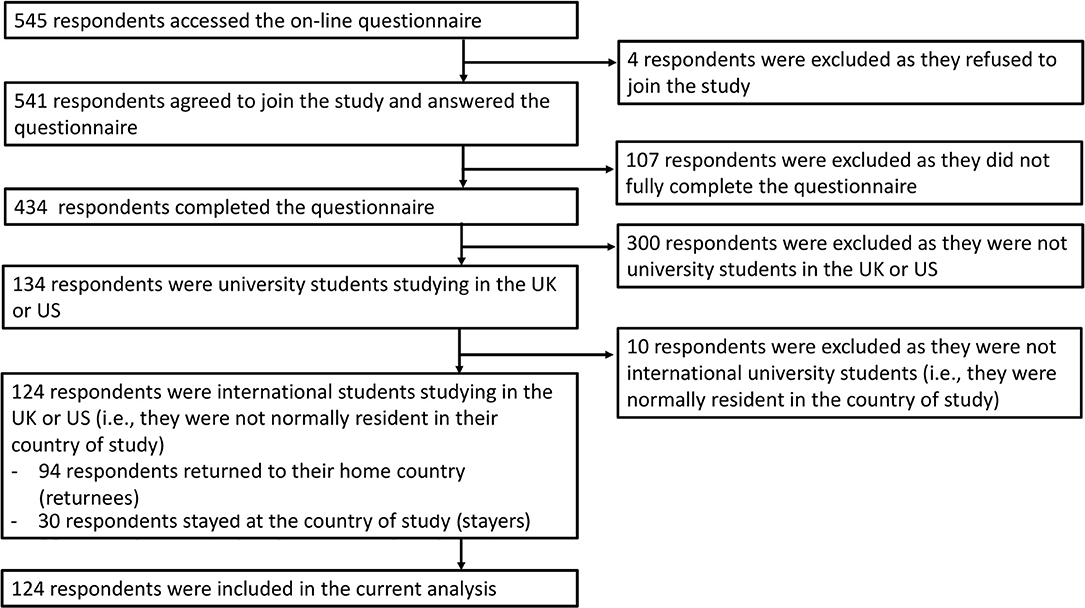- 1School of Nursing, The University of Hong Kong, Pokfulam, Hong Kong
- 2School of Chinese Medicine, The University of Hong Kong, Pokfulam, Hong Kong
- 3School of Health Science, Caritas Institute of Higher Education, Hong Kong, Hong Kong
- 4School of Public Health, The University of Hong Kong, Pokfulam, Hong Kong
- 5Department of Medicine, The University of Hong Kong, Pokfulam, Hong Kong
Background: The coronavirus disease 2019 (COVID-19) pandemic has disrupted university teaching globally. The mental health impacts on international university students have been overlooked.
Aims: This study examined the differences in COVID-19-related stressors and mental health impacts between international university students studying in the UK or USA who returned to their home country or region (returnees) and those who stayed in their institution country (stayers), and identified COVID-19-related stressors and coping strategies that were predictors of mental health.
Method: An online questionnaire survey was conducted from April 28 through May 12, 2020 using an exponential, non-discriminative snowball sampling strategy (registered at the National Institutes of Health: NCT04365361).
Results: A total of 124 full-time international university students (36.3% male) were included: 75.8% had returned to their home country or region for reasons related to COVID-19; 77.4% were pursuing a bachelor's program, and 53.2% were in programs with practicum component. 84.7% of all students had moderate-to-high perceived stress, 12.1% had moderate-to-severe symptoms of anxiety and depression, and 17.7% had moderate-to-severe symptoms of insomnia. Compared with returnees, stayers had significantly higher stress from COVID-19-related stressors such as personal health and lack of social support (Cohen's d: 0.57–1.11), higher perceived stress [10-item Perceived Stress Scale (PSS-10)] {22.6 ± 6.2 vs. 19.1 ± 6.1, β [95% confidence interval (CI)]: 4.039 (0.816, 7.261), Cohen's d: 0.52}, and more severe insomnia symptoms [Insomnia Severity Index (ISI)] [11.8 ± 6.1 vs. 7.6 ± 5.2, β (95% CI): 3.087 (0.262, 5.912), Cohen's d: 0.45], with moderate-to-large effect sizes. Compared with males, females reported significantly higher stress from uncertainties about academic program (Cohen's d: 0.45) with a small effect size. In the total sample, stress related to academics (e.g., personal attainment, uncertainties about academic program, and changes in teaching/learning format), health (including personal health and health of family and friends), availability of reliable COVID-19-related information, and lack of social support predicted more negative mental health impacts. Resilience, positive thinking, and exercise were predictors of less severe mental health impacts.
Conclusions: Stayers experienced more adverse mental health impacts than returnees. We call on educators and mental health professionals to provide appropriate support for international students, particularly the stayers, during the pandemic.
Introduction
The coronavirus disease 2019 (COVID-19) pandemic has aroused fear and anxiety globally, which may lead to an upsurge in the incidence and severity of mental health problems (1). Global attention has largely focused on infected patients and frontline health workers. Our PubMed search on June 26, 2020 using keywords including “international students,” “mental health,” “pandemic,” “epidemic,” and “outbreak” yielded a limited number of articles on the mental health impacts of COVID-19 in local students (2–4). We found one correspondence piece on the need for mental health care for Chinese international students and one qualitative article on 28 Chinese international students' health risk perception during travel (5, 6). However, there were no articles focused specifically on the mental health impacts of COVID-19 on international students; this group's mental health has been overlooked.
Many universities around the world have implemented preventive measures, including closing campuses or facilities, canceling classes, transitioning to online-based teaching/learning curriculum and examinations, and postponing practicums. However, up to now (mid-June 2020), many universities are still uncertain about how long such measures will continue, and it is unclear how these changes have affected students. Such disruptions due to the COVID-19 pandemic can exert unique additional pressures, adversely affecting students' mental health, with impacts including increased stress, anxiety, and depression (3, 4). In general, university students face a wide range of transitional events and ongoing stressors while adapting to new academic environments and demands. Ongoing stress can affect academic performance as well as mental well-being (7). Such stress may have a disproportionate impact on females compared with males. It has been demonstrated that stress exposure during puberty has stronger proximal effects on girls, including increased risks of developing mood- and stress-related disorders, such as depression, anxiety, and posttraumatic stress disorder (8). More psychological support from academic institutions is needed to enhance female students' mental health and resilience.
For international students, living abroad, adjustment to the host country's culture and norms, and being away from central social support systems such as family and friends can be additional challenges that affect mental health. Students from different countries may have different cultural characteristics, which might affect their coping strategies (9).
During the early stages of the outbreaks in the UK and USA (March 2020), publicly available information and recommendations were often unclear or conflicting. For example, while wearing face masks was not initially advised as a preventive measure, the international recommendations regarding masks subsequently changed. International students from Asia (e.g., students from Hong Kong) might have experienced conflict because places such as Hong Kong had almost 100% mass masking since the end of January and seen good outbreak control. These challenges might be amplified during difficult times such as the COVID-19 pandemic. For example, some Asian international students have reported experiencing isolation and discrimination because they were perceived as potential COVID-19 carriers in their institution country (6). Wearing masks could also be stigmatized.
The current study focused on international students, some of whom stayed in their institution country and some of whom returned to their home country or region (which had a less severe outbreak or with outbreak better controlled) during the COVID-19 pandemic during the COVID-19 outbreaks. During the survey period (from April 28, 2020 through May 12, 2020), the COVID-19 outbreaks were escalating, with average daily increases of 4,681 and 28,185 confirmed COVID-19 cases per day, and a total of 223,064 and 1,322,054 confirmed cases on May 12, 2020 in the UK and USA, respectively (10). In Hong Kong, to where most of the students returned, the situation was under control with zero to four local cases per day during the study period (11). Owing to the escalating outbreaks in their institution countries, many students had returned to their home country or region where the outbreaks were perceived to be under better control.
Since major university destinations for international students such as the UK and the USA had more serious pandemic outbreaks with strict lockdown measures that may have impeded normal access to social support from family, friends, and universities, we hypothesized that international university students who stayed in their institution country (stayers) would have higher stress from COVID-19-related stressors (including individual, interpersonal, and environmental factors), which were associated with higher negative mental health impacts (perceived stress, and symptoms of anxiety, depression, and insomnia), than those who returned to their home country or region (returnees). We also hypothesized that compared with males, females would have more adverse mental health impacts, since females might experience higher stress from COVID-19-related stressors.
The objectives of this study were to (i) investigate whether stayers face more or less stress from COVID-19-related stressors and mental health problems than returnees, (ii) examine the differences in COVID-19-related stressors and mental health impacts between males and females, (iii) explore the association between resilience and family functioning and the mental health impacts of COVID-19 on students, and (iii) identify the COVID-19-related stressors and coping strategies that predict students' perceived stress level [Perceived Stress Scale-10 (PSS-10)], severity of anxiety and depression symptoms [Patient Health Questionnaire-4 (PHQ-4)], and severity of insomnia symptoms [Insomnia Severity Index (ISI)].
Methods
Study Design and Participants
We conducted a cross-sectional online questionnaire survey to collect information on the mental health impacts of the COVID-19 outbreak, resilience, family functioning, and stress coping strategies in international students studying abroad. Written informed consent was obtained before answering the survey. Ethics approval was granted by the Institutional Review Board of The University of Hong Kong/Hospital Authority Hong Kong West Cluster (reference number: UW20-298). The study was registered with the National Institutes of Health (identifier number: NCT04365361).
The inclusion criteria targeted full-time international university student aged 18 years or older studying abroad in the UK or USA. Written informed consent was obtained from all respondents.
Procedures
The online questionnaire was distributed through an anonymous link with an exponential non-discriminative snowball sampling strategy. Considering time sensitivity, snowball sampling was a cost-effective and efficient method to reach our study population, which may have been difficult to sample otherwise (12). The link was first disseminated through the WhatsApp messaging platform to university students studying in Hong Kong or overseas. These students were encouraged to forward the survey link to their friends. To protect against duplicate responses, the online questionnaire was set up such that browser cookies would prevent respondents from taking the survey a second time using the same browser. Upon completion of the questionnaire, respondents received automatically computed scores with brief interpretations and explanations for scales included in the questionnaire in order to promote mental health awareness. No incentives were given to respondents, but links for reliable information on COVID-19 (e.g., link to the World Health Organization website) and telephone numbers for seeking help, support, or further information were provided.
Measurement Tools
A self-administered, anonymous questionnaire based on components of the transactional model of stress and adaptive coping was used to collect respondents' demographic characteristics, academic program, stress from COVID-19-related stressors, mental health impacts, resilience, family functioning, and stress coping strategies (13).
Academic Program Characteristics
Respondents were asked to indicate (i) their institution country, (ii) whether they were full-time or part-time students, (iii) whether they were final-year students, (iv) whether their academic program included a practicum component, and (v) whether the program was medical orZ health related.
Coronavirus Disease 2019-Related Stressors
Respondents were asked to indicate how stressful they found nine possible COVID-19-related stressors, under three groups: individual (academic attainment, personal health, and health of friends or family), interpersonal (lack of social support and prejudiced attitude or behavior of others), and environmental (uncertainties about the academic program, changes in teaching/learning format, the economic impact of COVID-19, and availability of reliable COVID-related information). Responses were made on a five-point Likert scale: “1 = not at all stressful,” “2 = mildly stressful,” “3 = moderately stressful,” “4 = very stressful,” and “5 = extremely stressful”.
Perceived Stress Scale -10
The ten-item Perceived Stress Scale -10 (PSS-10) was used to assess perceived stress by asking respondents how often they had certain thoughts and feelings during the past month. Scores ranged from 0 to 40, with cutoffs for low (0–13), moderate (14–26), and high (27–40) perceived stress. Cronbach's alpha of 0.83 was reported (14).
Patient Health Questionnaire-4
The four-item Patient Health Questionnaire-4 (PHQ-4) was used as an ultra-brief screening for symptoms of anxiety and depression. Scores ranged from 0 to 12, with cutoffs for normal (0–2), mild (3–5), moderate (6–8), and severe (9–12) anxiety and depression symptoms. Cronbach's alpha of 0.85 was reported (15).
Insomnia Severity Index
The seven-item Insomnia Severity Scale (ISI) was used to assess the severity of insomnia symptoms. Scores ranged from 0 to 28, with cutoffs for no clinically significant insomnia (0–7), subthreshold insomnia (8–14), moderate clinical insomnia (15–21), and severe clinical insomnia (22–28). Cronbach's alpha of 0.83 was reported (16).
Brief Assessment of Family Functioning Scale
The three-item Brief Assessment of Family Functioning Scale (BAFFS) was used to assess respondents' family functioning. Scores ranged from 4 to 12, with higher scores indicating greater family distress. Cronbach's alpha of 0.71 was reported (17, 18).
Connor–Davidson Resilience Scale-2
The two-item Connor–Davidson Resilience Scale-2 (CD-RISC-2) was used to assess adaptability and resilience. Scores ranged from 0 to 8, with higher scores indicating better adaptability and resilience. Cronbach's alpha of 0.79 was reported (19).
Coping Strategies
Respondents were asked to indicate, from a list, the coping strategies they had utilized within the past month to relieve COVID-19-related stress. The items included listening to music, eating or cooking, video or mobile gaming, seeking support from family and friends, browsing the web, positive thinking, exercise, religious support, and meditation.
Statistical Analysis
All quantitative statistical analyses were performed with SPSS for Windows (version 23.0). Chi-square test was used to examine the differences in the demographic characteristics and academic programs of the stayers and the returnees. Respondents who did not complete the questionnaires were excluded.
To control for potential confounders, the analyses were adjusted for sex (male vs. female), age group (18 to 25 vs. 25 years or older), ethnicity (Asian vs. non-Asian), country or region of residence (Hong Kong vs. others), country of study (UK vs. USA), education program level (undergraduate vs. postgraduate), program year (final year vs. non-final year), and field of study (medical or health-related vs. others).
Linear regression was used to examine the differences in stress from COVID-19-related stressors, mental health impacts [perceived stress levels (PSS-10), severity of anxiety and depression symptoms (PHQ-4), and severity of insomnia symptoms (ISI)], resilience (CD-RISC-2), and family functioning (BAFFS) between the stayers and returnees and between males and females. Binary multivariable logistic regression was used to examine the differences in the severity of perceived stress (“low” vs. “moderate to high”), anxiety and depression symptoms (“normal to mild” vs. “moderate to severe”), and insomnia symptoms (“none to threshold” vs. “moderate to severe”), between the stayers and returnees and between males and females.
For the total sample, analyses included forced entry of the above potential confounders, and respondents' return status (returnees vs. stayers). The linear relationship of mental health impacts with resilience and family functioning was examined using partial correlation coefficients.
Forward stepwise multiple linear regression was used to identify predictors of students' mental health impacts. First, the interaction effect between students' return status and sex was examined by forcing the return status by sex interaction term into the models. The dependent variables included perceived stress level, severity of anxiety and depression symptoms, and severity of insomnia symptoms. Academic program characteristics, COVID-19-related stressors, resilience, family functioning, and coping strategies were considered as independent variables influencing mental health impacts. If the interaction term (return status by sex) was not statistically significant, forward stepwise regression analysis was performed without the interaction term. The change in adjusted R2 was calculated with the removal of each significant variable from the model. All tests were two-sided, with P < 0.05 indicating statistical significance and P < 0.1 to P ≥ 0.5 indicating marginal statistical significance.
Results
Recruitment
A total of 545 students accessed the online survey during study period, and 541 agreed to join; 107 students who did not complete the questionnaire, 300 students not studying in the UK or USA, and 10 students who were not international students were excluded. Thus, the current analysis included 124 full-time international university students studying in the UK or USA who completed the questionnaire (Figure 1).
Participants
Of the 124 students included, 36.3% were males, 86.3% were aged 18–25 years, and 41.9% were final-year students; 77.4% were pursuing a bachelor's program, 46.0% were pursuing medical or health-related programs, and 53.2% were in programs with practicum component; 75.8% had returned to their home country or region for reasons related to COVID-19. Among the returnees, 81% had returned to their home country or region on or before the end of March. Table 1 shows that compared with stayers, more returnees were younger, studying in the UK, undergraduates, from Hong Kong, in their non-final year, and in medical or health-related fields.
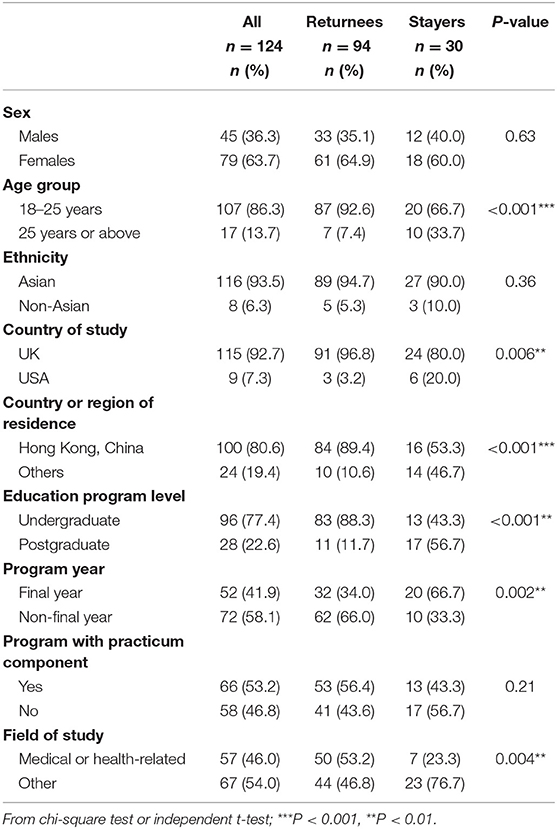
Table 1. Characteristics of international students in the UK and USA who returned to their home country or region (returnees) and those who stayed in their institution country (stayers).
Coronavirus Disease 2019-Related Stressors
Table 2 shows that compared with returnees, stayers reported significantly higher levels of stress related to personal health {β [95% confidence interval (CI)]: 0.560 (0.146, 0.975), P = 0.01, Cohen's d: 0.57} and lack of social support [β (95% CI): 1.206 (0.752, 1.660), P < 0.001, Cohen's d: 1.11], with moderate-to-large effect sizes. Stayers also had marginally significantly higher stress related to the availability of reliable information on COVID-19 [β (95% CI): 0.426 (−0.034, 0.887), P = 0.07, Cohen's d: 0.39] and the prejudiced attitude or behavior of others [β (95% CI): 0.413 (−0.058, 0.844), P = 0.09, Cohen's d: 0.38] than returnees with small-to-moderate effect sizes.

Table 2. Stress levels from coronavirus disease 2019 (COVID-19)-related stressors in the total student sample and subgroups.
Compared with males, females reported significantly higher stress related to uncertainties about academic program [β (95% CI): 0.578 (0.099, 1.056), P = 0.02, Cohen's d: 0.45] with small effect size and marginally significantly higher stress related to personal health [β (95% CI): 0.265 (−0.037, −0.568), P = 0.09 Cohen's d: 0.28].
Mental Health Impacts
Of all students, 84.7% had moderate-to-high perceived stress, 12.1% had moderate-to-severe symptoms of anxiety and depression, and 17.7% had moderate-to-severe symptoms of insomnia (Table 3). Perceived stress level, severity of symptoms of anxiety and depression, and severity of symptoms of insomnia were significantly associated with each other (all P < 0.001) and stress from COVID-19-related stressors (Table 4).
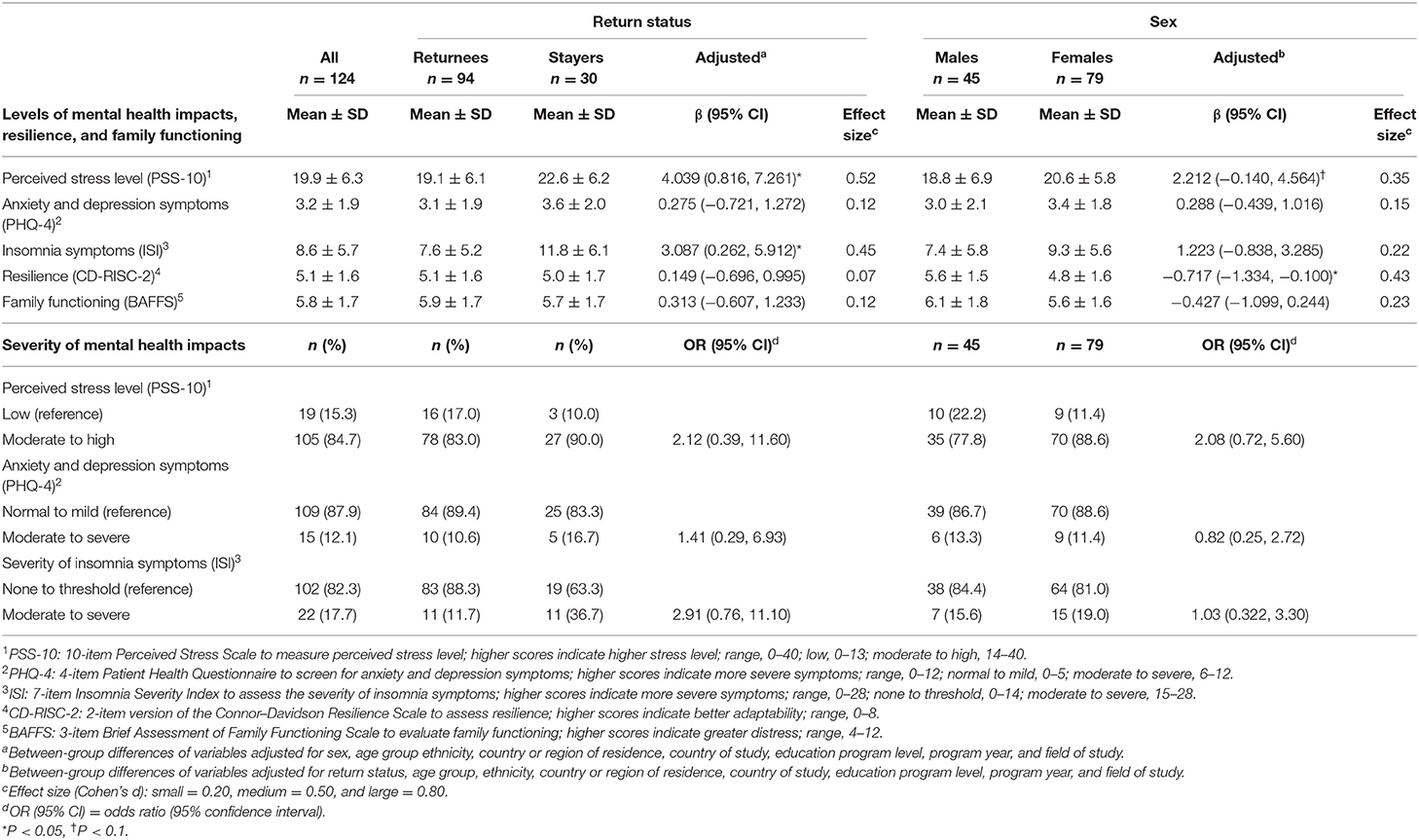
Table 3. Levels and severity of mental health impacts, resilience, and family functioning in the total student sample and subgroups.
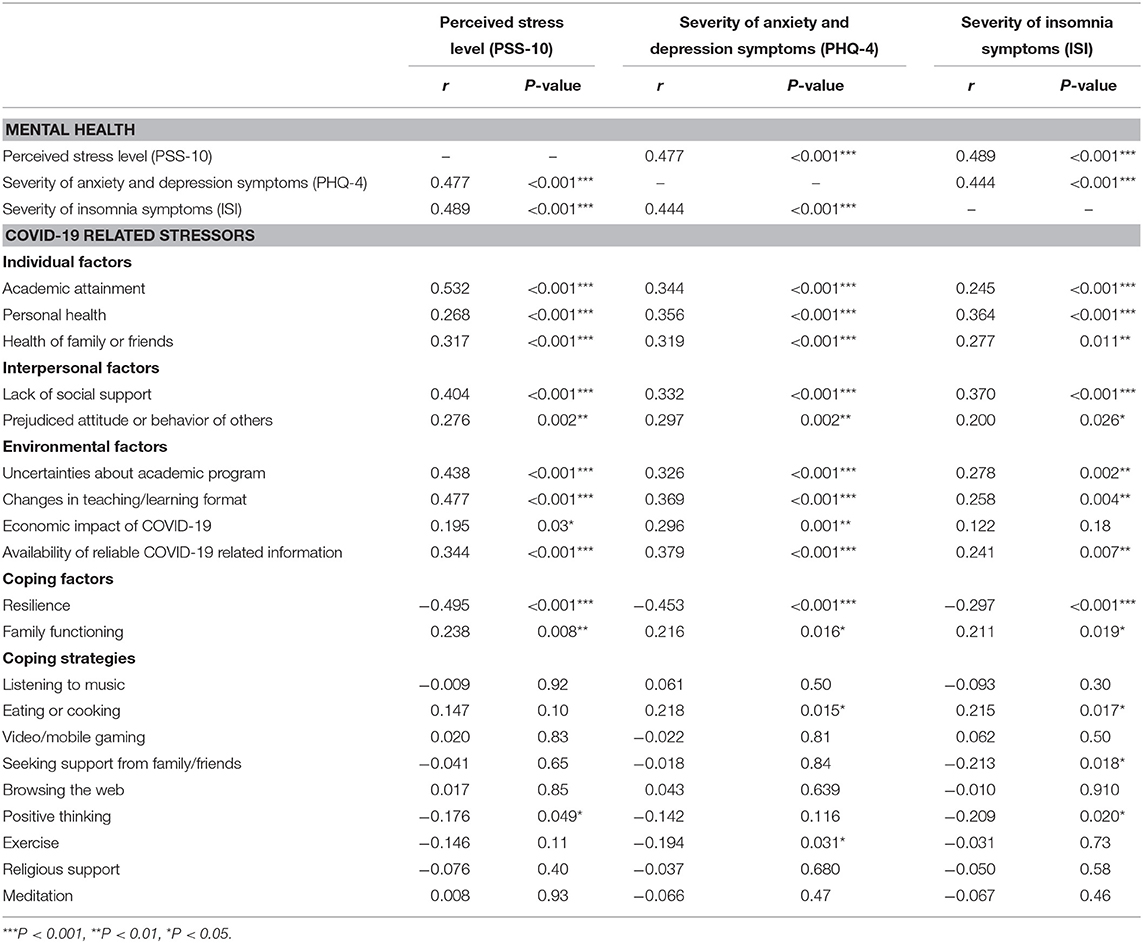
Table 4. Association between mental health impacts and coronavirus disease 2019 (COVID-19)-related stressors, coping factors, and strategies.
Compared with returnees, stayers had significantly higher perceived stress [PSS-10: 22.6 ± 6.2 vs. 19.1 ± 6.1, β (95% CI): 4.039 (0.816, 7.261), P = 0.02, Cohen's d: 0.52] and more severe insomnia symptoms [ISIs: 11.8 ± 6.1 vs. 7.6 ± 5.2, β (95% CI): 3.087 (0.262, 5.912), P = 0.03, Cohen's d: 0.46], with moderate effect sizes (Table 3). No significant difference in severity of anxiety and depression symptoms (PHQ-4) between returnees and stayers was found.
Compared with males, females reported marginally significantly higher perceived stress [PSS-10: 20.6 ± 5.8 vs. 18.8 ± 6.9, β (95% CI): 2.212 (−0.140, 4.564), P = 0.07, Cohen's d: 0.35] with small effect size. However, no significant difference in severity of anxiety and depression symptoms and insomnia symptoms between males and females was found.
Coronavirus Disease 2019-Related Stressors Predicting Mental Health Impacts
Table 4 shows that stress from all COVID-19-related stressors was significantly associated with perceived stress level, severity of anxiety and depression symptoms, and severity of insomnia symptoms (all P < 0.05), with the exception of stress from the economic impact of COVID-19, which was not significantly associated with the severity of insomnia symptoms (r = 0.122, P = 0.18).
For COVID-19-related stressors predicting mental health impacts, no statistically significant interaction effects of return status by sex were found (return status by sex interaction term: PSS-10, P = 0.18; PHQ-4, P = 0.07; ISI, P = 0.22). Table 5 shows that stress related to academic attainment (adjusted R2 = 23.4%) was the most important predictor of perceived stress level (PSS-10), followed by lack of social support and uncertainties about academic program. Stress related to the changes in teaching/learning format (adjusted R2 = 9.9%) was the most important predictor of the severity of anxiety and depression symptoms (PHQ-4), followed by health of family and friends and availability of reliable information on COVID-19. The most important predictor of the severity of insomnia symptoms (ISI) was stress related to personal health (adjusted R2 = 5.7%), followed by uncertainties about the academic program.
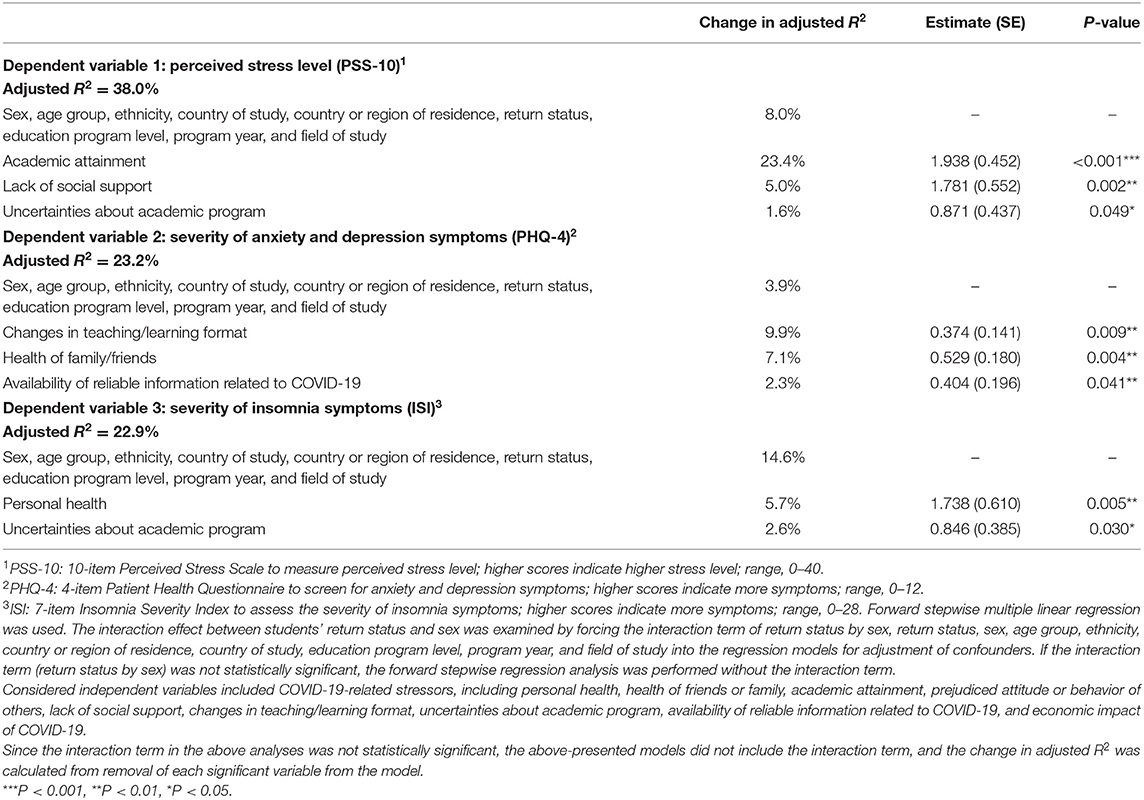
Table 5. Coronavirus disease 2019 (COVID-19)-related stressors as predictors of mental health impacts identified by forward stepwise multiple regression analysis (n = 124).
Resilience, Family Functioning, and Mental Health Impacts
Resilience was significantly negatively correlated with lower perceived stress level (PSS-10: r = −0.526, P < 0.001), severity of anxiety and depression symptoms (PHQ-4: r = −0.467, P < 0.001), and severity of insomnia symptoms (ISI: r = −0.328, P = 0.001) (Table 4). Compared with males, females reported significantly lower resilience [CD-RISC-2: 5.6 ± 1.5 vs. 4.8 ± 1.6, β (95% CI): −0.717 (−1.334, −0.100), P = 0.02, Cohen's d: 0.43] with small effect size. However, there was no significant difference in resilience between stayers and returnees (Table 3).
Family functioning (BAFFS; higher scores indicate greater distress) was significantly correlated with higher perceived stress level (PSS-10: r = 0.258, P = 0.008), severity of anxiety and depression symptoms (PHQ-4: r = 0.234, P = 0.0161), and severity of insomnia symptoms (ISI: r = 0.251, P = 0.02) (Table 4). No significant difference in resilience between stayers and returnees, as well as between males and females, was found (Table 3).
Resilience and Coping Strategies Predicting Mental Health Impacts
The top three most commonly used coping strategies among students during the COVID-19 pandemic were listening to music (78%), eating or cooking (66%), and video or mobile gaming (61%) (Figure 2).
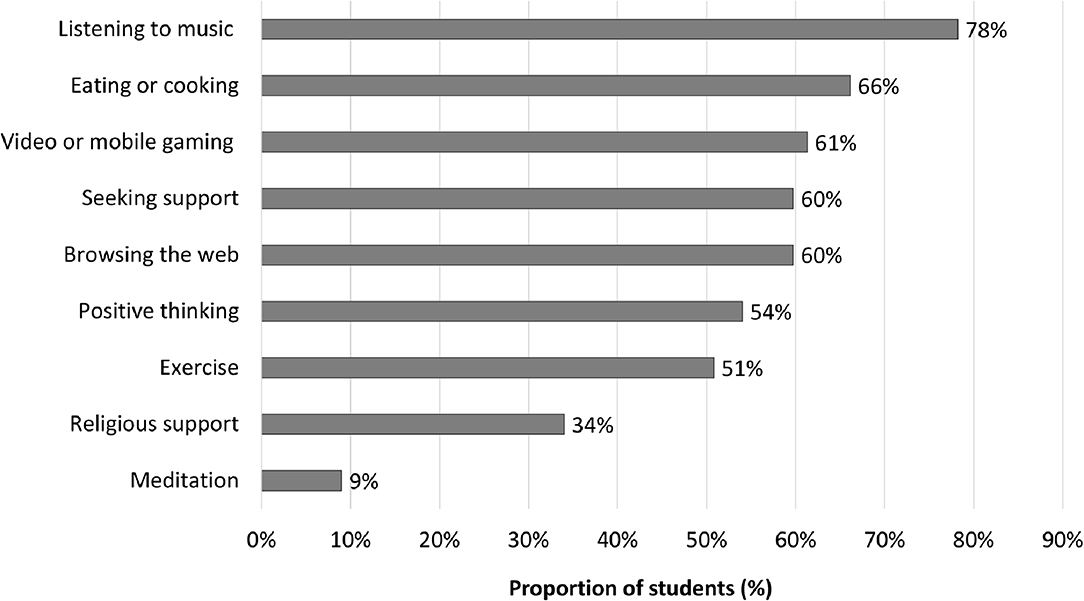
Figure 2. Coping strategies in response to coronavirus disease 2019 (COVID-19) for the total student sample.
Table 4 shows that eating or cooking was significantly positively associated with severity of anxiety and depression symptoms and insomnia symptoms. Positive thinking was significantly negatively associated with perceived stress and severity of insomnia symptoms. Exercise was significantly positively associated with severity of anxiety and depression symptoms (all P < 0.05).
The return status by sex interaction term was not significant (interaction term: PSS-10, P = 0.52; PHQ-4, P = 0.39; ISI, P = 0.52) and was not included in the forward stepwise multiple regression analysis.
Table 6 shows that resilience was the most important predictor of mental health impacts [perceived stress (PSS-10), adjusted R2 = 27.0%; severity of anxiety and depression symptoms (PHQ-4), adjusted R2 = 20.6%; severity of insomnia symptoms (ISI), adjusted R2 = 9.5%]. Positive thinking, exercise, and seeking support from family and friends were coping strategies that were predictors of less severe mental health impacts.
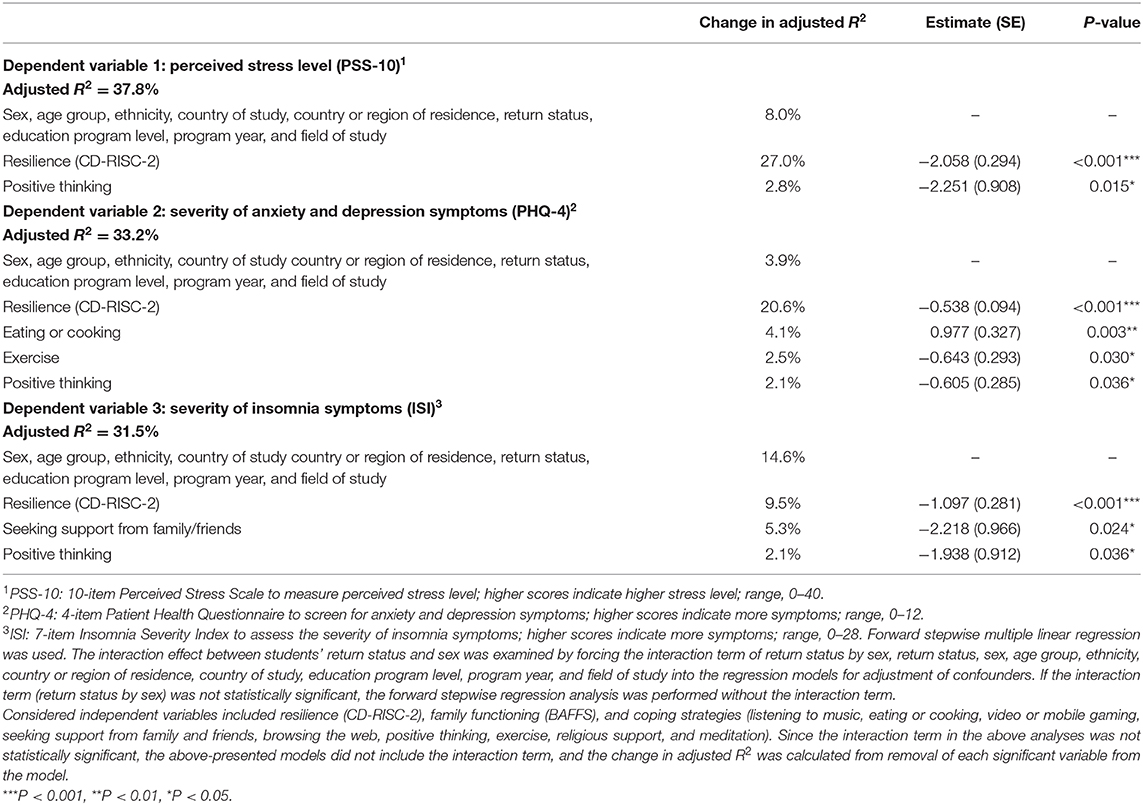
Table 6. Resilience and coping strategies as predictors of mental health impacts identified by forward stepwise multiple regression analysis (n = 124).
Discussion
Our study is the first study on stressors, coping strategies, and mental health impacts of COVID-19 in international students studying abroad. The findings showed that more than 80% of the students had moderate-to-high perceived stress. Stayers had higher stress related to personal health and lack of social support, perceived stress (PSS-10), and more ISIs than returnees; and females had higher stress related to uncertainties about the academic program and lower resilience than males.
In the sample, stress related to academics (e.g., personal academic attainment, uncertainties about the academic program, and changes in teaching/learning format), health (personal health and health of family and friends), availability of reliable COVID-19-related information, and lack of social support were predictive of higher perceived stress level and more severe anxiety and depression symptoms. Resilience and positive thinking were important coping strategies against negative mental health impacts.
A high proportion of students in our sample had moderate-to-severe perceived stress, which is consistent with the fact that university students often fall within the age range when common mental health problems are at their developmental peak (20). Students' stress may be exacerbated by experiences during the COVID-19 pandemic. In particular, Sahu noted that the closure of universities during the pandemic may pose monetary and mental health challenges to international students, among other challenges (21). We also found that females had higher stress related to uncertainties about academic program during the COVID-19 pandemic. This is consistent with other findings in the literature: Liu et al. found significantly greater increases in the prevalence and severity of posttraumatic symptoms in females, compared with males, during the initial phase of COVID-19 (22). Besides, significant bivariate associations were found between female and fear, as well as with mental health consequences (anxiety and depressive symptoms) (23).
In mass media, some international students have reported high stress related to difficulties obtaining air tickets at high prices, travel risks and restrictions, the quarantine process (for those planning to return home), and employment to cope with basic living expenses (for those planning to stay in their institution country) during the pandemic (24). We found that lack of social support was an important predictor of students' mental health. This is consistent with others' findings that social support is negatively correlated with adverse mental health impacts (25). Stayers reported higher stress than returnees. This difference could be explained by differences in the stayers and returnees' experiences: while stayers resided in their institution countries where the pandemic situation was not yet under control, information appeared unreliable, masking was stigmatized, and COVID-19-related policies were criticized as suboptimal, returnees could join their families in their home country or region. Returnees would have felt safer as COVID-19 was perceived to be under better control in their home country or region, while stayers would have experienced greater stress related to social isolation under mandatory lockdown in their institution countries amid unreliable information and controversial policies.
Implications
Our work has important implications for academic institutions, clinical work, and public health. First, academic institutions, particularly those in the UK and USA, should increase their awareness of additional needs and potential mental health problems experienced by their students. International students already face stress related to the acculturation demands of studying abroad (26), and students' stress may be amplified during a public health crisis. Academic institutions should show more understanding and empathy toward these students, especially stayers. Course management needs to consider how best to relieve students' academic-related stress. Education and training for educators and mental health professionals on identifying risk factors and symptoms of mental distress from COVID-19 for better identification and management of students' mental health are advised.
Stayers may hesitate to seek support for emotional problems, fear stigma, and prefer to handle problems alone (27). Even if they are motivated to seek support, the lockdown regulations may have made the usual face-to-face student assistance and counseling services inaccessible. Educators, institutions, and mental health professionals need to proactively reach out to their students to understand their needs and provide assistance. Student support groups or counseling via e-platforms are urgently needed to help students alleviate mental health problems and provide social, psychological, and academic support.
Family functioning and resilience were reported to have a strong association with negative mental health impacts. Family functioning is one of the important aspects of the family environment, which affects the physical, social, and emotional health of individuals (28). Resilience is a protective factor that buffers from the effects of traumatic experience, which enhances individual adaptation and positively influences successful adaptation and coping (29). Besides, resilience, positive thinking, and exercise were identified as important coping strategies that predicted less severe mental health impacts in our study. Online mental health education and mindfulness-based interventions can help students enhance their resilience (30). Academic institutions should enact effective action plans to promote students' resilience through the official academic curriculum or unofficial student extracurricular activities that can be run under a lockdown or social distancing regulations.
In public health, frequent misinformation and rumors about viruses are common causes of distress (31). We have found that the availability of reliable information about COVID-19 was an important stressor for international students during the pandemic. Stronger collaboration between different parties, such as universities and health departments, could help with the timely delivery of precise and easy-to-understand information to the public, helping in turn with disease prevention and the implementation of precautionary measures.
Limitations
Our study had several limitations. First, while snowball sampling was an effective strategy to recruit suitable respondents efficiently and allowed the study to capture valuable data at the height of the pandemic, sampling bias could have arisen from respondents forwarding the survey to peers with similar traits and characteristics (12) and the small sample size. The fact that no incentives were offered to respondents for their participation might explain the limited number of respondents recruited. We also wished to stop recruiting earlier so that our results could raise the alarm and call for remedial actions as soon as possible. Second and relatedly, the majority of the respondents (95%) were Asian, and our findings may not be applicable to other international students. Specifically, most of our respondents were students from Hong Kong studying in the UK. As the control measures for and the extent of the outbreaks of COVID-19 were different across countries, future studies should include international students across more countries and ethnicities. Finally, although the coping strategies included in our survey were strategies that may be popular among students, the list was not exhaustive, and popular strategies may not necessarily be the most effective strategies to protect against adverse mental health impacts. Further studies should investigate the efficacy of a more expansive series of coping strategies.
To conclude, the mental health impacts of COVID-19 on international students have been overlooked. We call on educators, academic institutions, and mental health professionals to provide appropriate support for their international students, particularly the stayers, during the pandemic.
Data Availability Statement
The raw data supporting the conclusions of this article will be made available by the authors, without undue reservation.
Ethics Statement
The studies involving human participants were reviewed and approved by the Institutional Review Board of The University of Hong Kong/Hospital Authority Hong Kong West Cluster (reference number: UW20-298). The patients/participants provided their written informed consent to participate in this study.
Author Contributions
AL and LL led the conception and design of the survey, carried out the survey, and were responsible for interpreting the data and drafting the manuscript. AL and L-mH were involved in the statistical analysis of the data. AL, LL, T-hL, M-pW, MI, YF, TT-kL, and VL were closely involved in data interpretation and manuscript revision. All authors read and approved the final manuscript.
Conflict of Interest
The authors declare that the research was conducted in the absence of any commercial or financial relationships that could be construed as a potential conflict of interest.
Acknowledgments
We would like to thank Miss Asa Choi and Miss Denise Yiu for helping with the recruitment and logistics for this study.
References
1. United Nations. COVID-19 and the Need for Action on Mental Health. (2020). Available online at: https://www.un.org/sites/un2.un.org/files/un_policy_brief-covid_and_mental_health_final.pdf
2. Zhang Y, Zhang H, Ma X, Di Q. Mental health problems during the COVID-19 pandemics and the mitigation effects of exercise: a longitudinal study of college students in China. Int J Environ Res Public Health. (2020) 17:3722. doi: 10.3390/ijerph17103722
3. Odriozola-González P, Álvaro Planchuelo-Gómez A, Irurtia MJ, Luis-García RD. Psychological effects of the COVID-19 outbreak and lockdown among students and workers of a Spanish University. Psychiatry Res. (2020) 290:113108. doi: 10.1016/j.psychres.2020.113108
4. Naser AY, Dahmash EZ, Al-Rousan R, Alwafi H, Alrawashdeh HM, Ghoul I, et al. Mental health status of the general population, healthcare professionals, and university students during 2019 coronavirus disease outbreak in Jordan: a cross-sectional study. Brain Behav. (2020) 10:e01730. doi: 10.1002/brb3.1730
5. Ma T, Heywood A, MacIntyre CR. Travel health risk perceptions of Chinese international students in Australia - implications for COVID-19. Infect Dis Health. (2020) 25:30018–3. doi: 10.1016/j.idh.2020.03.002
6. Zhai Y, Du X. Mental health care for international Chinese students affected by the COVID-19 outbreak. Lancet Psychiatry. (2020) 7:e22. doi: 10.1016/S2215-0366(20)30089-4
7. Dantzer R. Depression and inflammation: an intricate relationship. Biol Psychiatry. (2012) 71:4–5. doi: 10.1016/j.biopsych.2011.10.025
8. Hodes GE, Epperson CN. Sex differences in vulnerability and resilience to stress across the life span. Biol Psychiatry. (2019) 86:421–32. doi: 10.1016/j.biopsych.2019.04.028
9. Essau CA, Trommsdorff G. Coping with university-related problems: a cross-cultural comparison. J Cross Cult Psychol. (1996) 27:315–28. doi: 10.1177/0022022196273004
10. World Health Organization. WHO Coronavirus Disease (COVID-19) Dashboard. (2020). Available online at: https://covid19.who.int/
11. Centre for Health Protection - Hong Kong Department of Health. Latest Situation of Coronavirus Disease (COVID-19) in Hong Kong. (2020). Available online at: https://chp-dashboard.geodata.gov.hk/covid-19/en.html
12. Kirchherr J, Charles K. Enhancing the sample diversity of snowball samples: recommendations from research project on anti-dam movementsin Southest Asia. PLoS ONE. (2018) 13:e0201710. doi: 10.1371/journal.pone.0201710
13. Lazarus RS, Folkman S. Stress, Appraisal, and Coping. New York, NY: Springer Publishing Company (1984).
14. Leung DY, Lam TH, Chan SS. Three versions of perceived stress scale: validation in a sample of Chinese cardiac patients who smoke. BMC Public Health. (2010) 10:513. doi: 10.1186/1471-2458-10-513
15. Kroenke K, Spitzer RL, Williams J, Löwe B. An ultra-brief screening scale for anxiety and depression: the PHQ-4. Psychosomatics. (2009) 50:613–21. doi: 10.1016/S0033-3182(09)70864-3
16. Chung K-F, Kan KK-K, Yeung W-F. Assessing insomnia in adolescents: comparison of insomnia severity index, athens insomnia scale and sleep quality index. Sleep Med. (2011) 12:463–70. doi: 10.1016/j.sleep.2010.09.019
17. Shek DTL. Assessment of family functioning in Chinese adolescents: the Chinese version of the family assessment device. Res Soc Work Pract. (2002) 12:502–24. doi: 10.1177/1049731502012004003
18. Mansfield AK, Keitner GI, Sheeran T. The brief assessment of family functioning scale (BAFFS): a three-item version of the general functioning scale of the family assessment device. Psychother Res. (2019) 29:824–31. doi: 10.1080/10503307.2017.1422213
19. Ni MY, Li TK, Yu NX, Pang H, Chan BHY, Leung GM, et al. Normative data and psychometric properties of the Connor-Davidson Resilience Scale (CD-RISC) and the abbreviated version (CD-RISC2) among the general population in Hong Kong. Qual Life Res. (2016) 25:111–6. doi: 10.1007/s11136-015-1072-x
20. Reavley N, Jorm AF. Prevention and early intervention to improve mental health in higher education students: a review. Early Interv Psychiatry. (2010) 4:132–42. doi: 10.1111/j.1751-7893.2010.00167.x
21. Sahu P. Closure of universities due to Coronavirus disease 2019 (COVID-19): impact on education and mental health of students and academic staff. Cureus. (2020) 12:e7541. doi: 10.7759/cureus.7541
22. Liu N, Zhang F, Wei C, Jia Y, Shang Z, Sun L, et al. Prevalence and predictors of PTSS during covid-19 outbreak in china hardest-hit areas: gender differences matter. Psychiatry Res. (2020) 287:112921. doi: 10.1016/j.psychres.2020.112921
23. Fitzpatrick KM, Harris C, Drawve G. Fear of COVID-19 and the mental health consequences in America. Psychol Trauma. (2020) 2020:S17–21. doi: 10.1037/tra0000924
24. South China Morning Post. The Coronavirus Pandemic. Economy Seats Sell Out for Business-Class Fares as Travellers Fleeing a Worsening Covid-19 Pandemic Bid for Limited Flights to China. Available online at: https://www.scmp.com/business/article/3076961/economy-seats-go-business-class-fares-travellers-fleeing-worsening-covid (accessed March 26, 2020).
25. Cao W, Fang Z, Hou G, Han M, Xu X, Dong J, et al. The psychological impact of the COVID-19 epidemic on college students in China. Psychiatry Res. (2020) 287:112934. doi: 10.1016/j.psychres.2020.112934
26. Smith RA, Khawaja NG. A review of the acculturation experiences of international students. Int J Intercult Relat. (2011) 35:699–713. doi: 10.1016/j.ijintrel.2011.08.004
27. Ebert DD, Mortier P, Kaehlke F, Bruffaerts R, Baumeister H, Auerbach RP, et al. Barriers of mental health treatment utilization among first-year college students: first cross-national results from the WHO world mental health international college student initiative. Int J Methods Psychiatr Res. (2019) 28:e1782. doi: 10.1002/mpr.1782
28. Franks P, Campbell TL, Shields CG. Social relationships and health: the relative roles of family functioning and social support. Soc. Sci. Med. (1992) 34: 779–88. doi: 10.1016/0277-9536(92)90365-w
29. Wagnild G. Resilience and successful aging: comparison among low and high income older adults. J Gerontol Nurs. (2003). 29:42–9. doi: 10.3928/0098-9134-20031201-09
30. Galante J, Dufour G, Vainre M, Wagner AP, Stochl J, Benton A, et al. A mindfulness-based intervention to increase resilience to stress in university students (the Mindful Student Study): a pragmatic randomised controlled trial. Lancet Public Health. (2018) 3:e72–e81. doi: 10.1016/S2468-2667(17)30231-1
Keywords: mental health, stress, anxiety, depression, insomnia, students, university, coping
Citation: Lai AY-k, Lee L, Wang M-p, Feng Y, Lai TT-k, Ho L-m, Lam VS-f, Ip MS-m and Lam T-h (2020) Mental Health Impacts of the COVID-19 Pandemic on International University Students, Related Stressors, and Coping Strategies. Front. Psychiatry 11:584240. doi: 10.3389/fpsyt.2020.584240
Received: 16 July 2020; Accepted: 21 September 2020;
Published: 23 November 2020.
Edited by:
Chung-Ying Lin, National Cheng Kung University, TaiwanReviewed by:
Carol Strong, National Cheng Kung University, TaiwanIqbal Pramukti, Universitas Padjadjaran, Indonesia
Copyright © 2020 Lai, Lee, Wang, Feng, Lai, Ho, Lam, Ip and Lam. This is an open-access article distributed under the terms of the Creative Commons Attribution License (CC BY). The use, distribution or reproduction in other forums is permitted, provided the original author(s) and the copyright owner(s) are credited and that the original publication in this journal is cited, in accordance with accepted academic practice. No use, distribution or reproduction is permitted which does not comply with these terms.
*Correspondence: Agnes Yuen-kwan Lai, YWduZXNsYWlAaGt1Lmhr
 Agnes Yuen-kwan Lai
Agnes Yuen-kwan Lai Letitia Lee1
Letitia Lee1 Man-ping Wang
Man-ping Wang Yibin Feng
Yibin Feng Tai-hing Lam
Tai-hing Lam